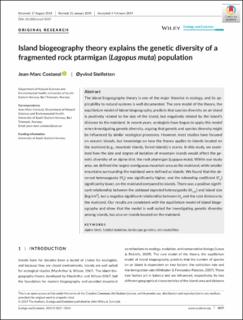| dc.description.abstract | The island biogeography theory is one of the major theories in ecology, and its applicability to natural systems is well documented. The core model of the theory, the equilibrium model of island biogeography, predicts that species diversity on an island is positively related to the size of the island, but negatively related by the island's distance to the mainland. In recent years, ecologists have begun to apply this model when investigating genetic diversity, arguing that genetic and species diversity might be influenced by similar ecological processes. However, most studies have focused on oceanic islands, but knowledge on how the theory applies to islands located on the mainland (e.g., mountain islands, forest islands) is scarce. In this study, we examined how the size and degree of isolation of mountain islands would affect the genetic diversity of an alpine bird, the rock ptarmigan (Lagopus muta). Within our study area, we defined the largest contiguous mountain area as the mainland, while smaller mountains surrounding the mainland were defined as islands. We found that the observed heterozygosity (Ho) was significantly higher, and the inbreeding coefficient (Fis) significantly lower, on the mainland compared to islands. There was a positive significant relationship between the unbiased expected heterozygosity (Hn.b.) and island size (log km2), but a negative significant relationship between Ho and the cost distance to the mainland. Our results are consistent with the equilibrium model of island biogeography and show that the model is well suited for investigating genetic diversity among islands, but also on islands located on the mainland. | en_US |

